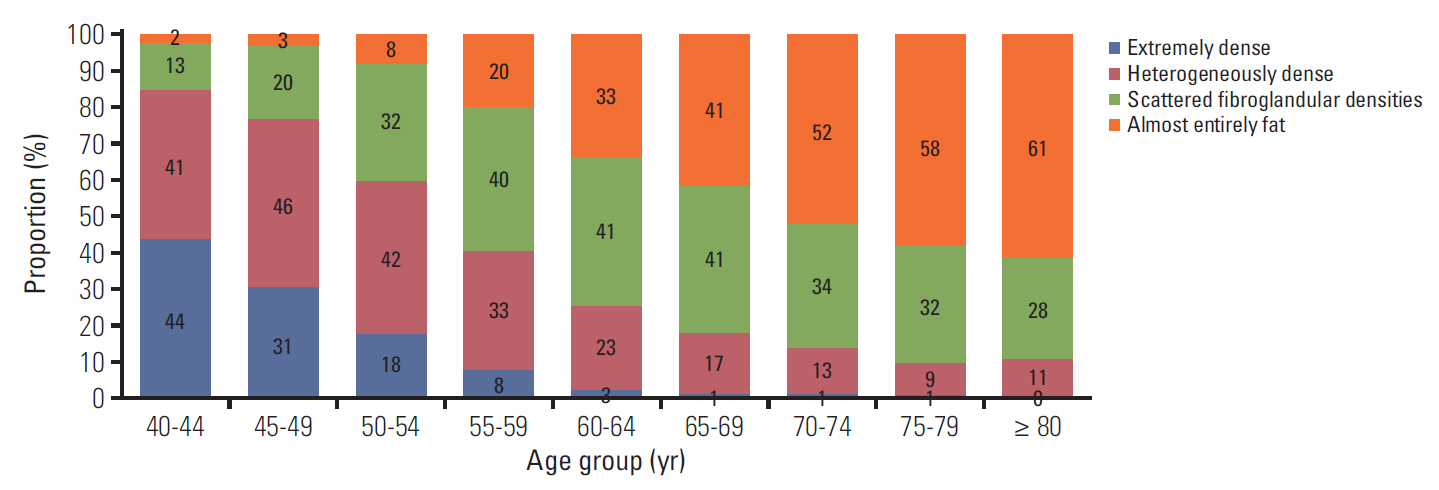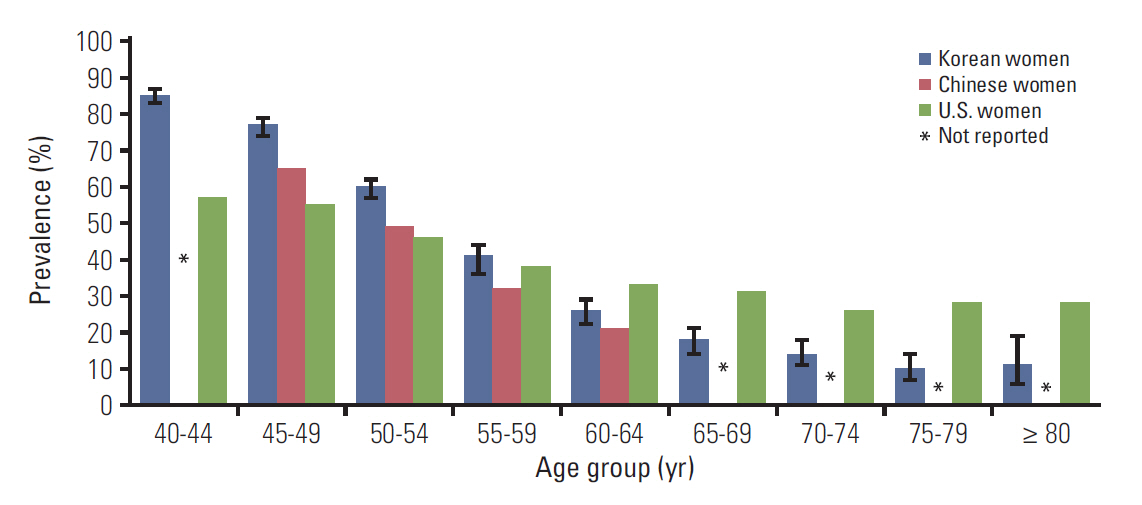Cancer Res Treat.
2019 Oct;51(4):1295-1301. 10.4143/crt.2018.297.
Prevalence of Women with Dense Breasts in Korea: Results from a Nationwide Cross-sectional Study
- Affiliations
-
- 1National Cancer Control Institute, National Cancer Center, Goyang, Korea. jkjun@ncc.re.kr
- 2Department of Radiology, Soonchunhyang University Bucheon Hospital, Soonchunhyang University College of Medicine, Bucheon, Korea.
- 3Center for Breast Cancer, National Cancer Center Hospital, National Cancer Center, Goyang, Korea.
- 4Department of Radiology, College of Medicine, The Catholic University of Korea, Seoul, Korea.
- 5Department of Radiology, Research Institute of Radiology, Asan Medical Center, University of Ulsan College of Medicine, Seoul, Korea.
- 6Department of Radiology, Gangnam Healthcare Center, Seoul National University Hospital, Seoul, Korea.
- 7Department of Radiology, CHA Bundang Medical Center, CHA University, Seongnam, Korea.
- KMID: 2460579
- DOI: http://doi.org/10.4143/crt.2018.297
Abstract
- PURPOSE
Women with dense breast are known to be at high risk for breast cancer, but their prevalence and number of Korean women are unknown. The current study was to investigate the distribution of mammographic breast density by age of women undergoing screening mammography, and to estimate the prevalence of Korean women with dense breasts, quantitatively.
MATERIALS AND METHODS
For obtaining a nationwide representative sample, 6,481 mammograms were collected from 86 screening units participated in the National Cancer Screening Program for breast cancer. Based on the American College of Radiology Breast Imaging Reporting and Data System classification, breast density was evaluated by six breast radiologists, qualitatively. We applied these breast density distributions to age-specific counts of the Korean women population derived to mid-year 2017 to estimate the number of Korean women with dense breasts.
RESULTS
Overall, 54.4% (95% confidence interval [CI], 52.9% to 55.8%) of women 40 to 69 years of age had heterogeneously or extremely dense breasts, and this proportion was inversely associated with age. Based on the age distribution of Korean women, we estimated that 6,083,000 women (95% CI, 5,919,600 to 6,245,600) age 40-69 years in Korean have dense breasts. Women aged 40-49 years (n=3,450,000) accounted for 56.7% of this group.
CONCLUSION
More than half of Korean women aged 40 and over have dense breasts. To prevent breast cancer effectively and efficiently, it is necessary to develop a new personalized prevention strategy considering her status of breast density.
Keyword
MeSH Terms
Figure
Cited by 1 articles
-
Impact of Awareness of Breast Density on Perceived Risk, Worry, and Intentions for Future Breast Cancer Screening among Korean Women
Anh Thi Ngoc Tran, Ji Hae Hwang, Eunji Choi, Yun Yeong Lee, Mina Suh, Chan Wha Lee, Yeol Kim, Kui Son Choi
Cancer Res Treat. 2021;53(1):55-64. doi: 10.4143/crt.2020.495.
Reference
-
References
1. Boyd NF, Martin LJ, Yaffe MJ, Minkin S. Mammographic density and breast cancer risk: current understanding and future prospects. Breast Cancer Res. 2011; 13:223.
Article2. Astley SM, Harkness EF, Sergeant JC, Warwick J, Stavrinos P, Warren R, et al. A comparison of five methods of measuring mammographic density: a case-control study. Breast Cancer Res. 2018; 20:10.
Article3. Bae JM, Kim EH. Breast density and risk of breast cancer in Asian women: a meta-analysis of observational studies. J Prev Med Public Health. 2016; 49:367–75.
Article4. Park B, Cho HM, Lee EH, Song S, Suh M, Choi KS, et al. Does breast density measured through population-based screening independently increase breast cancer risk in Asian females? Clin Epidemiol. 2018; 10:61–70.
Article5. Nyante SJ, Sherman ME, Pfeiffer RM, Berrington de Gonzalez A, Brinton LA, Aiello Bowles EJ, et al. Prognostic significance of mammographic density change after initiation of tamoxifen for ER-positive breast cancer. J Natl Cancer Inst. 2015; 107:dju425.
Article6. Tice JA, Cummings SR, Smith-Bindman R, Ichikawa L, Barlow WE, Kerlikowske K. Using clinical factors and mammographic breast density to estimate breast cancer risk: development and validation of a new predictive model. Ann Intern Med. 2008; 148:337–47.
Article7. Trentham-Dietz A, Kerlikowske K, Stout NK, Miglioretti DL, Schechter CB, Ergun MA, et al. Tailoring breast cancer screening intervals by breast density and risk for women aged 50 years or older: collaborative modeling of screening outcomes. Ann Intern Med. 2016; 165:700–12.
Article8. Holm J, Humphreys K, Li J, Ploner A, Cheddad A, Eriksson M, et al. Risk factors and tumor characteristics of interval cancers by mammographic density. J Clin Oncol. 2015; 33:1030–7.
Article9. Boyd NF, Rommens JM, Vogt K, Lee V, Hopper JL, Yaffe MJ, et al. Mammographic breast density as an intermediate phenotype for breast cancer. Lancet Oncol. 2005; 6:798–808.
Article10. Maskarinec G, Nagata C, Shimizu H, Kashiki Y. Comparison of mammographic densities and their determinants in women from Japan and Hawaii. Int J Cancer. 2002; 102:29–33.
Article11. Maskarinec G, Pagano I, Chen Z, Nagata C, Gram IT. Ethnic and geographic differences in mammographic density and their association with breast cancer incidence. Breast Cancer Res Treat. 2007; 104:47–56.
Article12. Mariapun S, Li J, Yip CH, Taib NA, Teo SH. Ethnic differences in mammographic densities: an Asian cross-sectional study. PLoS One. 2015; 10:e0117568.
Article13. McCormack VA, Perry N, Vinnicombe SJ, Silva Idos S. Ethnic variations in mammographic density: a British multiethnic longitudinal study. Am J Epidemiol. 2008; 168:412–21.
Article14. Habel LA, Capra AM, Oestreicher N, Greendale GA, Cauley JA, Bromberger J, et al. Mammographic density in a multiethnic cohort. Menopause. 2007; 14:891–9.
Article15. Kim SH, Kim MH, Oh KK. Analysis and comparison of breast density according to age on mammogram between Korean and western women. J Korean Radiol Soc. 2000; 42:1009–14.
Article16. Youn I, Choi S, Kook SH, Choi YJ. Mammographic breast density evaluation in Korean women using fully automated volumetric assessment. J Korean Med Sci. 2016; 31:457–62.
Article17. Sprague BL, Gangnon RE, Burt V, Trentham-Dietz A, Hampton JM, Wellman RD, et al. Prevalence of mammographically dense breasts in the United States. J Natl Cancer Inst. 2014; 106:dju255.
Article18. Dai H, Yan Y, Wang P, Liu P, Cao Y, Xiong L, et al. Distribution of mammographic density and its influential factors among Chinese women. Int J Epidemiol. 2014; 43:1240–51.
Article19. Jun JK, Kim MJ, Choi KS, Suh M, Jung KW. Development of a sampling strategy and sample size calculation to estimate the distribution of mammographic breast density in Korean women. Asian Pac J Cancer Prev. 2012; 13:4661–4.
Article20. American College of Radiology. Breast Imaging Reporting and Data System. 4th ed. Reston, VA: American College of Radiology;2003.21. Jo HM, Song S, Lee EH, Ko K, Kang BJ, Cha JH, et al. Interpretive volume and inter-radiologist agreement on assessing breast density. J Korean Soc Breast Screening. 2018; 15:15–22.22. Ishihara S, Taira N, Kawasaki K, Ishibe Y, Mizoo T, Nishiyama K, et al. Association between mammographic breast density and lifestyle in Japanese women. Acta Med Okayama. 2013; 67:145–51.23. Suh M, Song S, Cho HN, Park B, Jun JK, Choi E, et al. Trends in participation rates for the national cancer screening program in Korea, 2002-2012. Cancer Res Treat. 2017; 49:798–806.
Article24. Lee EH, Kim KW, Kim YJ, Shin DR, Park YM, Lim HS, et al. Performance of screening mammography: a report of the Alliance for Breast Cancer Screening in Korea. Korean J Radiol. 2016; 17:489–96.
Article25. Kim YJ, Lee EH, Jun JK, Shin DR, Park YM, Kim HW, et al. Analysis of participant factors that affect the diagnostic performance of screening mammography: a report of the Alliance for Breast Cancer Screening in Korea. Korean J Radiol. 2017; 18:624–31.
Article26. Are You Dense Advocacy Inc. [Internet]. Woodbury, CT: Are You Dense Advocacy Inc.;2018. [cited 2018 Apr 13]. Available from: http://www.areyoudenseadvocacy.org.27. Lee EH, Park B, Kim NS, Seo HJ, Ko KL, Min JW, et al. The Korean guideline for breast cancer screening. J Korean Med Assoc. 2015; 58:408–19.
Article28. Jung KW, Won YJ, Kong HJ, Lee ES; Community of Population-Based Regional Cancer Registries. Cancer statistics in Korea: incidence, mortality, survival, and prevalence in 2015. Cancer Res Treat. 2018; 50:303–16.
Article29. Jung KW, Won YJ, Kong HJ, Lee ES. Prediction of cancer incidence and mortality in Korea, 2018. Cancer Res Treat. 2018; 50:317–23.
Article
- Full Text Links
- Actions
-
Cited
- CITED
-
- Close
- Share
- Similar articles
-
- Reproductive and Hormonal Factors Associated with Fatty or Dense Breast Patterns among Korean Women
- Distribution of dense breasts using screening mammography in Korean women: a retrospective observational study
- Evaluation of the Value of Multiplex MicroRNA Analysis as a Breast Cancer Screening in Korean Women under 50 Years of Age with a High Proportion of Dense Breasts
- Automated Breast Ultrasound Screening for Dense Breasts
- Association between pregnancy and acute appendicitis in South Korea: a population-based, cross-sectional study



